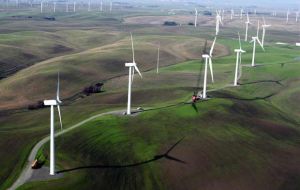MercoPress. South Atlantic News Agency
Uruguay's FDI equivalent to 5% of GDP and mostly in alternative energies, said Eclac report
 Several wind farm projects should increase Uruguay's energy capacity by 550MW
Several wind farm projects should increase Uruguay's energy capacity by 550MW Foreign direct investment in Uruguay totaled 2.79bn dollars last year, which is slightly higher than the 2.68bn of 2012, equivalent to 5% of GDP, according to the latest report on FDI for the region from the UN Economic Commission for Latin America and the Caribbean.
“The level of FDI received by Uruguay is very high for the region, equivalent to 5% of GDP in 2013. New capital contributions make up 62% of FDI while 30% is reinvestment and the rest in loans among companies” says the ECLAC report on Uruguay.
The 2012 data indicates the beginning of a recovery of investment in public services which that year increased on average from 16 million to 117 million dollars. The increase in consistent with the promotion that the Uruguayan government has done for investment in wind farms and the robust reply from that sector, says the report.
“French Akuo Energy for example has two main wind farm projects in construction which are demanding 205 million dollars; Spain's Abengoa is building a similar 70MW plant investing 165 million and Corporation America, from Argentina has plans to spend 210 million dollars in two similar wind farm projects”.
At the end of the day, in 2014 the wind energy projects will have a joint capacity of 550MW. Likewise the bidding process for several solar energy projects are in process, and these should consolidate an estimated 300 million dollars.
Finally besides energy, the issue most relevant issue regarding investment in Uruguay refers to the ”controversy regarding the proposal for the iron ore mining project in Aratirí, presented by Zamin international, with main offices in London, according to the report.
Once completed the alternative energy projects, Uruguay's power matrix should depend approximately 30% on these new undertakings. Uruguay has a majority of hydro energy, but as consumption increases it has become increasingly dependent on fossil sources of which the country in a net importer.




Top Comments
Disclaimer & comment rules-

-

-

Read all comments“At the end of the day, in 2014 the wind energy projects will have a joint capacity of 550MW.”
May 31st, 2014 - 12:00 pm 0So that will be an average of 550 x 7% = 38.5 MW available power, if the UK is anything to go by.
And with all the thousands of these things installed around the UK just look at the contribution they all make. Hover your mouse pointer over the wind meter and read the notes wind ”subsidies are always paid”, but not for much longer.
http://www.gridwatch.templar.co.uk/
I wonder who will be paying for these damn things: hang on I will go and have a look in the mirror.
It’s no wonder these companies come to Uruguay, the entire western world is already waking up to this nonsense and cutting subsidies which is leading to cancellation of contracts. Good.
ChrisR @ 1
Jun 01st, 2014 - 09:23 am 0Chris, as an engineer do you think wind farms are a dying technology? What would you like to see in Uruguay's case?
@ 2 ynsere
Jun 01st, 2014 - 01:36 pm 0Windmills are a useful thing if you live in the Falklands and have plenty of established wind currents, but even then they have high maintenance demands the cost which must be added to the price of the electricity generated.
The windmills I see in Uruguay are more often than not stationary. No much use then, are they?
What I would do to ensure continuity of supply is to go for CCGT: combined cycle gas turbines: gas turbines whose exhaust gases are used to heat water to steam to drive other alternators or whatever is needed. These machines have very high efficiency and can be put online (connected to the grid) within one hour of start-up.
The CCGT element in the UK today, as I type this is 31.12%, by far the biggest supply element.
The plants are not expensive to build and are very reliable. Yes, they need scheduled maintenance but the costs are known beforehand and don’t come out of the blue as happens so often with windmills. One of the mistakes that Uruguay has made in my judgement is to go for a “whole cost” contract. The price of the electricity includes maintenance. That sounds like a good idea except the manufacturers (who are usually the “contractors” signing the deals) obviously pad the price so that they are not out of pocket. Given the really poor availability (the light running) they are making even more money!
This is what happens when you get government monopolies making the decisions: UTE have demonstrated their lamentable decision making once before on the CHP plant when they couldn’t even recognise the actually supplier in the large divisions that the global company had. Do these people actually know anything?
The other thing is the removal of the ridiculous taxation that our government puts on everything including the LNG that would be used for CCGT. If they are serious about moving the country forward then the supply of affordable electricity must be a priority and windmills will not do it.
Commenting for this story is now closed.
If you have a Facebook account, become a fan and comment on our Facebook Page!